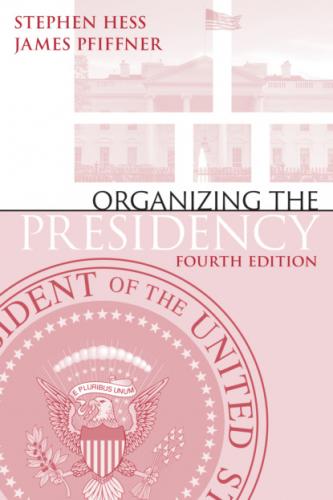Organizing
the
Presidency
FOURTH EDITION
STEPHEN HESS
and
JAMES P. PFIFFNER
BROOKINGS INSTITUTION PRESS
Washington, D.C.
Copyright © 2021
THE BROOKINGS INSTITUTION
1775 Massachusetts Avenue, N.W.
Washington, D.C. 20036
All rights reserved. No part of this publication may be reproduced or transmitted in any form or by any means without permission in writing from the Brookings Institution Press.
The Brookings Institution is a private nonprofit organization devoted to research, education, and publication on important issues of domestic and foreign policy. Its principal purpose is to bring the highest quality independent research and analysis to bear on current and emerging policy problems. Interpretations or conclusions in Brookings publications should be understood to be solely those of the authors.
Library of Congress Control Number: 2020943211
ISBN 9780815738411 (paperback)
ISBN 9780815738428 (ebook)
9 8 7 6 5 4 3 2 1
Typeset in Adobe Caslon Pro
Composition by Elliott Beard
CONTENTS
THE EVOLVING MODERN PRESIDENCY
6
LYNDON B. JOHNSON
7
RICHARD M. NIXON ■ GERALD R. FORD
8
JIMMY CARTER ■ RONALD W. REAGAN
9
GEORGE H. W. BUSH ■ WILLIAM J. CLINTON
10
GEORGE W. BUSH
11
BARACK H. OBAMA
12
DONALD J. TRUMP
Conclusion
FOURTEEN PRESIDENCIES
Acknowledgments
Notes
Index
1
THE EVOLVING MODERN PRESIDENCY
The modern presidency began with Franklin Delano Roosevelt and his leadership of the United States through the Great Depression and World War II. Beginning with that extraordinary period, we will trace the evolution of the presidency from the perspective of how FDR and his successors have organized their administrations, with a focus on White House organization and presidential relations with the cabinet. This is the fourth edition of Organizing the Presidency. The first edition, 1976, took the presidency from FDR (1933–1945) through the administration of Richard Nixon (1969–1974). The second edition, 1988, continued the march of presidents through Ronald Reagan’s two terms (1981–1989). The third edition, 2002, ended with the reaction of George W. Bush to the 9/11 terrorist attacks. This edition continues into Donald Trump’s first three years in office, as he sought to win the 2020 election.
The past ninety years have transformed the White House from a small, personalized office to a set of centralized bureaucracies (with hundreds of people) in charge of the much larger bureaucracies (of millions of people) in the broader executive branch. FDR did not try to run or manage the executive branch from the White House, at least not in the sense that a chief executive office runs or manages a corporation. During Roosevelt’s first two terms, he structured the White House staff to serve his personal needs. His staff was considerably larger though not significantly different from that of his predecessors. Because Roosevelt, in the manner of his cousin Theodore, conceived the presidency as a “bully pulpit,” his assistants were mostly engaged in helping him try to shape public opinion.
No National Security Council or National Economic Council existed then with responsibilities for departmental oversight. There was no congressional relations office in the White House. Presidential assistants were considered utility infielders who were moved from one position to another as needed, or as the president’s fancy dictated. While Roosevelt did not seek collective counsel from his cabinet, cabinet officers still had the major responsibility for running their departments, drafting legislation, and lobbying it through Congress. At the same time, however, Roosevelt created myriad new agencies reporting directly to him, which impinged on the jurisdiction of the cabinet departments.
According to Joseph Alsop, in FDR’s time:
There literally was no White House staff of the modern type, with policymaking functions. Two extremely pleasant, unassuming, and efficient men, Steve Early and Marvin McIntyre, handled the president’s day-to-day schedule and routine, the donkey-work of his press relations, and such like. There was a secretarial camarilla of highly competent and dedicated ladies who were led by “Missy” LeHand.… There were also lesser figures to handle travel arrangements, the enormous flow of correspondence, and the like. But that was that; and national policy was strictly a problem for the president, his advisers of the moment (who had constant access to the president’s office but no office of their own in the White House), and his chosen chiefs of departments and agencies.1
The increased number of governmental programs and the large number of agencies created during the New Deal resulted in a fragmented system that FDR tried to rein in through the proposals of the Brownlow Committee, which declared, “The President needs help.” With new reorganization authority, FDR created the Executive Office of the President in 1939, which vastly expanded FDR’s outreach, and he began to see a president’s task as including management. In his twelve years in the White House, Roosevelt created many elements of the modern presidency in embryonic form, and by his death in 1945, the president, rather than Congress, had become the center of federal attention. The long-term result of the Brownlow proposals was an increasingly centralized capacity to control the executive branch from the White House, a trend that increased in momentum after 1960.
The office of the presidency reflected historic changes in international relations and technology. Just as the world would never be the same after the Great Depression, World War II, and the advent of modern communications,
